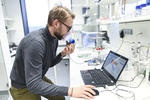A breath of fresh information
Direktzugriff
Artikelaktionen
The sensor still isn't sensitive enough to carry out measurements on people – but soon doctors and perhaps patients as well will be able, with Dincer's help, to monitor the course of an illness. Photo: Patrick Seeger
Freiburg, Jan 24, 2020
The air that people with asthma, diabetes, and other illnesses breathe out contains certain molecules in telltale amounts. University of Freiburg microsystems engineer Dr. Can Dincer can measure these substances with a simple, inexpensive, new type of paper-based sensor. The electrochemical sensors do not require any fluid – which has otherwise been necessary – to do their job. Dincer says he is considering setting up a start-up for his breath sensors because the principle can be extended to a range of applications.
A breath can betray a great deal. People who have inflamed airways exhale increased amounts of hydrogen peroxide. "We can measure the increased H2O2 content of the exhaled gas using a simple, inexpensive method," says Can Dincer. The doctor of engineering and junior research group leader at the Freiburg Center for Interactive Materials and Bioinspired Technologies (FIT) and of the Department of Microsystems Engineering (IMTEK) at the University of Freiburg has together with his team developed a paper-based electrochemical sensor. "It's brand-new. Comparable systems require liquid to work," explains Dincer. "Our paper is just moist – it almost works as if it were a solid liquid," he continues. Dincer is considering whether to found a start-up because the principle can be extended to many applications.
Monitoring the course of disease
"Diabetics exhale raised amounts of glucose," says Dincer, adding that this could be a potential area for sensor use. At the same time, he emphasizes, "We're still at the very beginning." The H2O2 sensor still isn't sensitive enough for measurements on people. Up to now, the tests have been run on a breath simulator – a machine that breathes like a human. The paper sensor recognizes when the machine exhales increased amounts of H2O2. People who have lung inflammation, asthma, or lung cancer show this symptom. Yet the sensor does not reveal what is causing the problem. It records changes in H2O2 content – increases and decreases – across a course of regular measurements. In this way, the course of an illness can be monitored and treatment efficacy evaluated by doctors, or perhaps even patients themselves.
The paper sensor is lightweight, inexpensive, and only a few square centimeters in size. It fits into conventional respiratory masks. The foundation of the device is a cellulose membrane with conducting strips on it – like an electronic chip. The heart of the system is made up of two geometrically identical electrodes. One detects the background noise in the exhaled air, or everything that emits disruptive signals. The other electrode is specially sensitized to respond to H2O2 as well. Its reading, minus the background, is the amount of H2O2 detected. "Normally, electrodes measure in conductive fluid," explains Dincer, "yet our electrodes measure on a paper membrane that is only as moist as the surrounding air." But the breath's humidity is one hundred percent. The paper membrane has been pretreated with salts. It draws the water it needs from the moist air exhaled onto it. "After just a few minutes, it's so damp that we can start measuring," adds the microsystems engineer. Dincer says that's one of his tricks – using paper treated with salt as a dry ion carrier or a solid liquid. "We've registered a patent for this sensor concept," he adds.
Series producible
The sensor, explains Dincer, offers many advantages compared to similar membranes and electronic measuring devices. These either work with expensive materials that are problematic to dispose of, or they are large and heavy. "Beyond that, it's no problem to produce our system in a series," he elaborates. "We simply print the electrodes and conducting strips on the paper," Dincer says. In principle, his membranes can carry biomolecules, such as nucleic acids, antibodies, or enzymes as well. When the enzyme glucose-oxidase encounters glucose, for example, H2O2 is yielded as well. That would already give Dincer a bloodless, non-invasive means of testing blood sugar concentrations, because the glucose content of the blood correlates with that of the breath. "Actually, you can measure just about anything with the system," muses Dincer and looks far into the future. He says, "My dream would be people using something that helps them which I at least contributed to developing."
Dincer wasn't banking on the sensor being the first step towards achieving that goal. After completing his microsystems engineering studies and writing an award-winning doctoral thesis at IMTEK, Dincer carried out research in Freiburg while simultaneously working as a visiting researcher at Imperial College in London as well. That's where he came upon paper-based sensors for electrochemical applications. Says Dincer, "I wanted to bring this expertise to Freiburg." A sensor specialist at IMTEK, Prof. Dr. Gerald Urban, and Dincer tendered a Master's thesis on the issue. Student Daniela Maier and chemist Elmar Laubender from Dincer’s team successfully took on the topic. Applying the sensor to analyze the breath then coincidentally came as a result of a project with Prof. Dr. Stefan Schumann, who heads the Clinical Respiration Physiology Workgroup at the Freiburg University Medical Center. "He made a measurement station with a breathing simulator, respiration masks and devices available to us," says Dincer.
A teamwork enthusiast
"It's been a success all around," the microsystems engineer explains. In the meantime, he's also become the associate editor of the specialist journal "Biosensors and Bioelectronics." At the end of 2019, he received the Adolf Martens Prize. "That's one of the most important honors for materials scientists," says a pleased Dincer. He describes himself as a fan of cooperative work. "Freiburg is unique in that respect," he adds, praising the infrastructure of the research institutes and attitudes of his colleagues. Can Dincer concludes, "I've never had a cooperation offer turned down."
Jürgen Schickinger
Fußzeile
Benutzerspezifische Werkzeuge

